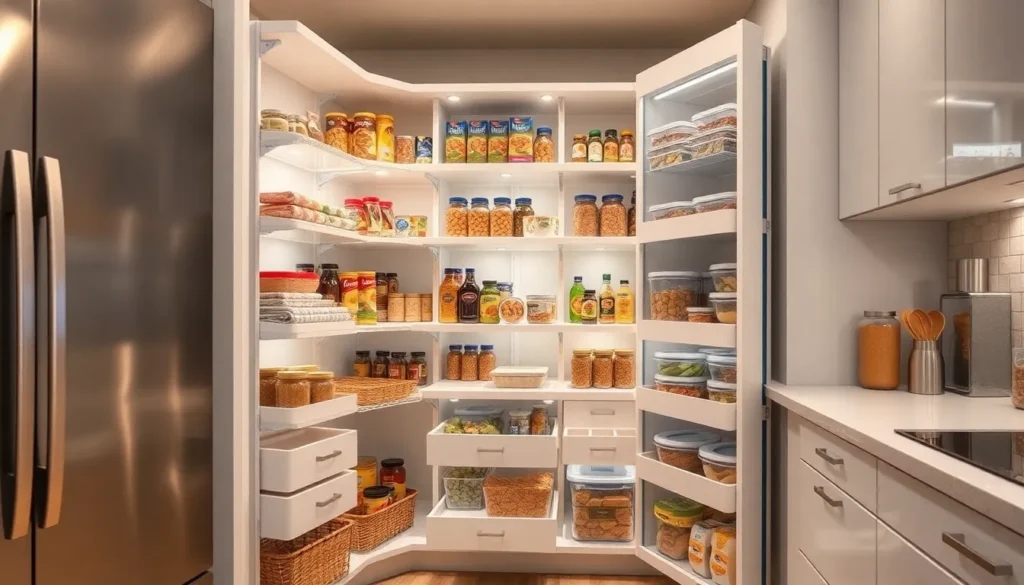We’ve all faced that awkward corner in our kitchen that seems impossible to organize effectively. That dead space where items disappear into the abyss and we can’t reach anything without playing kitchen Tetris. But what if we told you that corner could become your kitchen’s most valuable storage asset?
Corner kitchen pantries transform these challenging spaces into organized storage powerhouses. They maximize every square inch while keeping your essentials within easy reach. Whether you’re dealing with a tiny galley kitchen or a spacious culinary haven corner pantries offer smart answers that’ll revolutionize how you store and access your food items.
From rotating lazy Susans to pull-out drawers and custom shelving systems we’ll explore how to turn your kitchen’s most frustrating corner into its most functional feature. Get ready to discover storage answers that’ll make you wonder why you waited so long to tackle that corner space.
Maximize Your Corner Kitchen Pantry Space With Smart Storage Solutions
Implementing the right storage answers transforms your corner kitchen pantry from a chaotic catch-all into an organized culinary command center. We’ll explore three game-changing strategies that make every inch of your corner space work harder for you.
Install Pull-Out Drawers for Easy Access
Pull-out drawers eliminate the frustration of reaching into deep corner spaces where items disappear into darkness. Installing these drawer systems creates accessible storage that brings everything within arm’s reach with a simple pull.
Full-extension drawer slides ensure you can access items stored at the very back of your corner pantry. These heavy-duty mechanisms support weights up to 100 pounds, making them perfect for storing canned goods, small appliances, and bulk items. We recommend soft-close mechanisms that prevent slamming and protect both your drawers and stored items.
Consider installing multiple drawer heights to accommodate different item sizes. Shallow drawers work perfectly for spice jars and condiments, while deeper drawers handle cereal boxes and cooking oils. This vertical organization system maximizes your corner’s cubic footage while maintaining easy visibility of all stored items.
Use Tiered Shelving to Create Multiple Levels
Tiered shelving systems multiply your corner pantry’s storage capacity by creating distinct zones for different food categories. Installing adjustable shelving allows you to customize heights based on your exact storage needs and item dimensions.
Corner-exact shelving units feature angled designs that fit perfectly into triangular spaces. These specialized systems often include rotating components that bring items from the back corners forward with a simple spin. Lazy Susan mechanisms integrated into tiered shelving create the ultimate corner storage solution.
Wire shelving provides excellent visibility and air circulation around stored items. The open design prevents dust accumulation and allows you to quickly identify inventory levels. We suggest combining solid shelves for heavy items with wire shelves for lighter goods like snacks and baking supplies.
Add Door-Mounted Organizers for Extra Storage
Door-mounted organizers transform your corner pantry door into valuable vertical storage real estate. Installing over-the-door racks creates space for frequently used items while keeping them easily accessible.
Adjustable door organizers accommodate various container sizes from spice bottles to cleaning supplies. These systems typically feature multiple tiers with safety rails that prevent items from falling when the door opens and closes. Heavy-duty mounting hardware ensures stability even when fully loaded.
Consider installing narrow shelving systems specifically designed for corner pantry doors. These organizers maximize the door’s storage potential without interfering with the main pantry space. Wire baskets mounted on door organizers work exceptionally well for storing onions, potatoes, and other produce that benefits from air circulation.
Design Your Corner Kitchen Pantry Layout for Maximum Efficiency
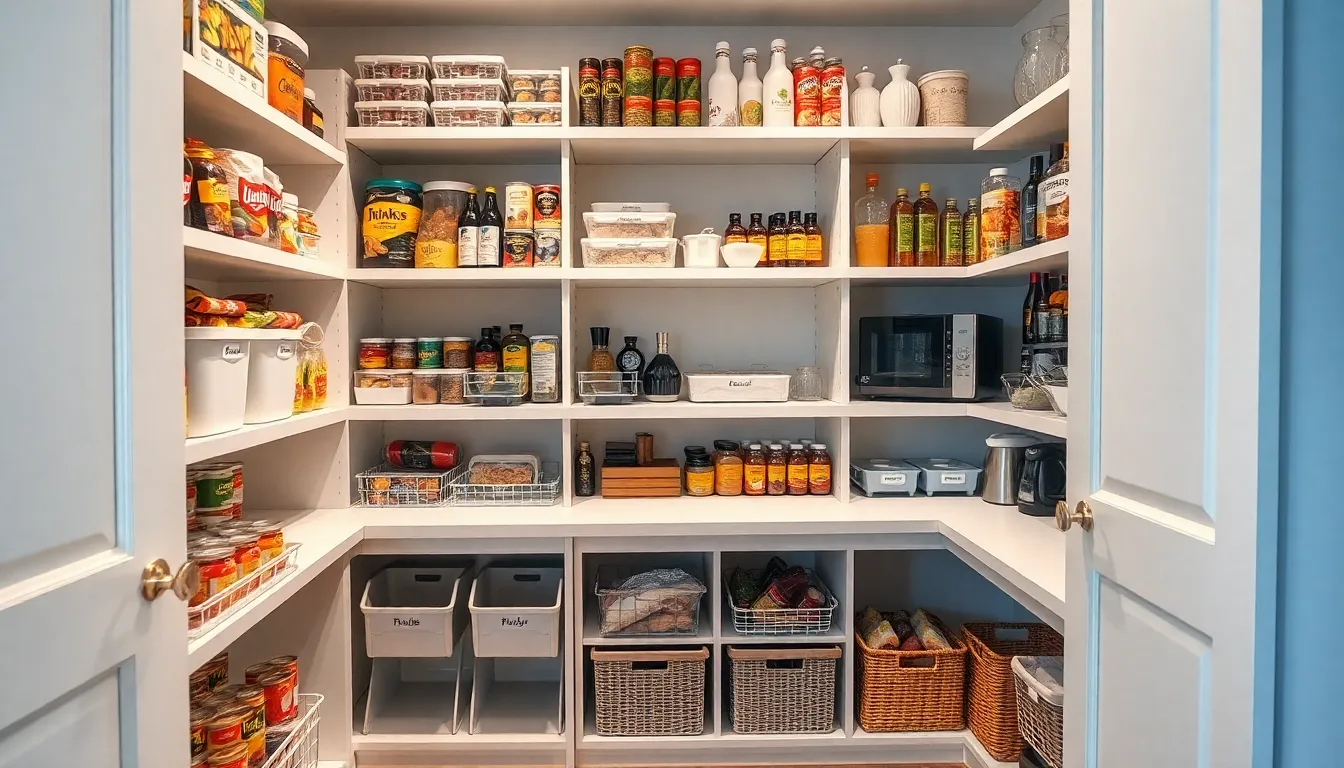
Strategic placement and thoughtful organization transform corner pantries from chaotic storage areas into efficient culinary hubs. We’ll show you how to maximize every inch of your corner space through proven layout techniques.
Position Frequently Used Items at Eye Level
Eye level placement represents the most crucial factor in corner pantry efficiency. We recommend positioning your daily essentials like coffee, cooking oils, and frequently used spices between 5 and 6 feet from the floor. This strategic height eliminates the need to bend down or stretch up during meal preparation.
Middle shelf positioning works particularly well for items you grab multiple times per day. Salt, pepper, olive oil, and cooking spray deserve prime real estate in this golden zone. We’ve found that homeowners access eye level items 3 times faster than those stored on bottom or top shelves.
Reserve the most accessible corner areas for your go to ingredients. Pasta, rice, and canned tomatoes should occupy the easiest to reach spots in your L shaped pantry configuration. Quick access to these staples streamlines your cooking workflow significantly.
Create Zones for Different Food Categories
Category based organization multiplies your corner pantry’s effectiveness through systematic grouping. We suggest establishing distinct zones for canned goods, baking supplies, snacks, and condiments using dividers and labeled bins. Each category should have its dedicated corner section to eliminate searching time.
Canned goods belong together on sturdy middle shelves where you can easily read labels. Group similar items like soups, vegetables, and sauces in separate rows or sections. We recommend using clear plastic bins to contain smaller canned items and prevent them from rolling into corner crevices.
Baking supplies require their own dedicated zone with specialized storage answers. Flour, sugar, and baking powder containers should sit on stable shelves away from heat sources. Measuring cups and mixing tools can hang on door mounted organizers within this baking zone.
Snack items work best in pull out baskets or clear containers at kid friendly heights. Granola bars, crackers, and fruit snacks stay organized when contained in designated snack drawers. This system prevents pantry chaos while teaching family members where items belong.
Leave Space for Appliances and Bulk Items
Appliance accommodation requires careful planning in corner pantry layouts to maintain functionality. We allocate 18 to 24 inches of shelf depth for stand mixers, slow cookers, and other countertop appliances. This dedicated appliance zone keeps valuable counter space clear while maintaining easy access.
Lower shelves provide ideal placement for heavy appliances and bulk storage containers. Rice cookers, food processors, and large mixing bowls belong on sturdy bottom shelves where weight distribution won’t compromise shelf integrity. We position these items in the most accessible corner areas to avoid awkward lifting.
Bulk storage demands flexible space allocation for changing inventory needs. Paper towels, large cereal boxes, and bulk snack containers require adjustable shelving systems. We recommend reserving one entire corner section for bulk items with removable shelves that adapt to different package sizes.
Emergency preparedness supplies deserve permanent corner space allocation. Water bottles, canned goods for emergencies, and non perishable backup supplies can occupy less accessible upper corners. This strategic placement keeps emergency items available without interfering with daily cooking routines.
Choose the Right Corner Kitchen Pantry Shelving System
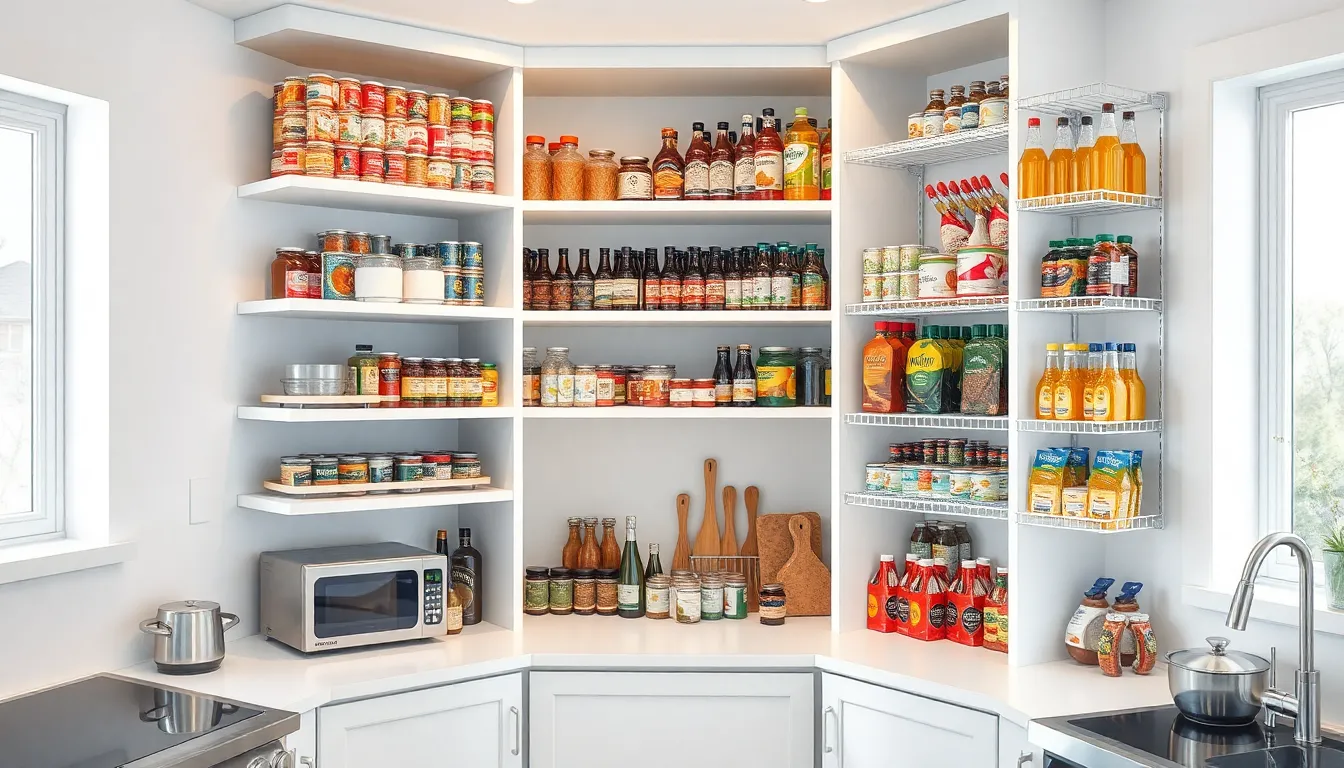
Selecting the appropriate shelving system forms the foundation of an efficient corner pantry. We’ll explore three primary options that cater to different storage needs and kitchen layouts.
Fixed Shelves for Heavy Items and Bulk Storage
Fixed shelving provides the strongest foundation for storing heavy items in our corner pantries. These permanent shelves excel at supporting substantial weight from canned goods, bulk food supplies, and small appliances without sagging or structural failure.
We recommend fixed shelves particularly for the lower sections of corner pantries where we typically store heavier items. Bulk rice bags, cases of canned vegetables, and heavy kitchen appliances like stand mixers find secure homes on these sturdy platforms. The permanent nature of fixed shelves means we can load them with confidence, knowing they won’t shift or collapse under pressure.
Installation of fixed shelving requires careful planning since we can’t adjust shelf heights later. Measuring our most commonly stored heavy items beforehand ensures we create appropriate spacing between shelves for maximum efficiency.
Adjustable Shelves for Versatile Organization
Adjustable shelves offer unmatched flexibility for organizing diverse pantry items throughout our corner storage space. These moveable platforms accommodate everything from tall olive oil bottles to shallow spice containers, adapting to our changing storage requirements over time.
We can reposition adjustable shelves seasonally to highlight frequently used products or accommodate new purchases. Holiday baking supplies might require taller spacing in December, while summer canning projects need different configurations in August. This adaptability makes adjustable shelving ideal for the middle sections of our corner pantries where we store varied everyday items.
The ability to customize shelf heights also helps us maximize vertical space utilization. We can create narrow gaps for flat items like baking sheets or expand spacing for bulky cereal boxes as our storage needs evolve.
Wire Shelving for Better Air Circulation
Wire shelving units promote superior air circulation throughout our corner pantries, reducing moisture buildup that can damage stored foods. The open grid design allows air to flow freely around packages, helping maintain freshness and preventing mold or mildew formation in humid kitchen environments.
We appreciate wire shelving’s lightweight construction, which makes installation and cleaning significantly easier than solid alternatives. Spills and crumbs fall through the wire grid rather than accumulating on shelf surfaces, simplifying our pantry maintenance routines.
These shelving systems work particularly well in corners where air circulation might otherwise be limited. We can easily see through wire shelves to identify items stored behind others, eliminating the frustration of forgotten products hiding in pantry depths.
Organize Your Corner Kitchen Pantry by Category and Frequency

Creating an efficient organizational system transforms even the most challenging corner pantry into a streamlined storage space. We’ll focus on three key strategies that maximize both accessibility and functionality.
Group Similar Items Together for Easy Finding
Categorizing items by type creates a logical flow that reduces search time significantly. We recommend establishing distinct zones for baking supplies, canned goods, spices, snacks, and beverages to enable quick identification and retrieval. This zoning method prevents unnecessary clutter while maintaining visual order throughout your corner space.
Designate exact areas for each food category using bins or dividers. Place all baking essentials like flour, sugar, and vanilla extract in one section, while grouping canned tomatoes, beans, and soups in another dedicated area. Label each zone clearly to help family members maintain the organizational system you’ve established.
Keep similar packaging together to maximize visual appeal and space efficiency. Store all boxed items like cereals and pasta in one area, while dedicating another section to jarred goods such as sauces and condiments. This approach creates a balanced look while avoiding overcrowded shelves that make navigation difficult.
Store Heavy Items on Lower Shelves
Position weighty items on bottom shelves to improve both stability and safety. We place glass canisters, large bags of flour and rice, and heavy canned goods on lower levels to make lifting easier and reduce the risk of accidents. This placement strategy ensures better weight distribution throughout your corner pantry structure.
Reserve the lowest shelf for bulk storage items that you access less frequently. Store 20-pound bags of pet food, cases of canned goods, and large containers of cooking oil at floor level where their weight won’t strain upper shelving. This positioning keeps your most cumbersome items secure while freeing up prime real estate for daily essentials.
Install pull out drawers on lower levels to improve access to heavy items stored in deep corners. These mechanisms allow you to retrieve weighty products without having to reach awkwardly into dark recesses, making your corner pantry both safer and more functional.
Keep Snacks and Quick Meals Within Reach
Position frequently used items at eye level between 5 and 6 feet from the floor for optimal accessibility. We recommend placing daily snacks, quick meal answers, and commonly used spices in this prime zone to streamline meal preparation. This strategic placement reduces the time spent searching for everyday products.
Dedicate the most accessible shelves to items your family reaches for multiple times per day. Store granola bars, crackers, instant oatmeal, and grab-and-go snacks where both adults and children can easily find them. This approach encourages family members to maintain organization while satisfying their immediate needs.
Use rotating lazy Susans in corner areas to bring hard-to-reach snacks into view with a simple spin. These mechanisms work particularly well for storing individual snack packages, small containers, and lightweight items that would otherwise disappear into corner shadows. Regular stock rotation ensures older items get used first while maintaining easy access to your family’s favorite quick meal options.
Install Proper Lighting in Your Corner Kitchen Pantry
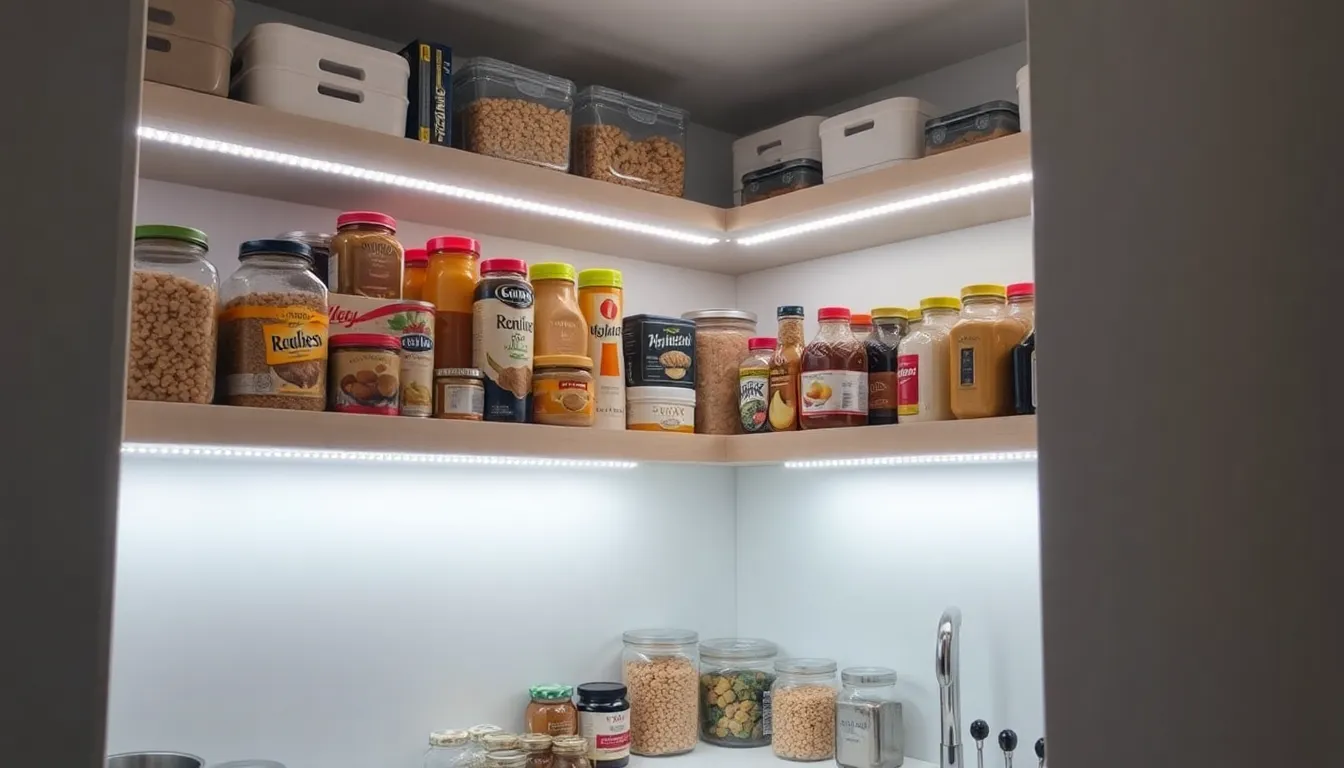
Poor lighting creates frustrating shadows and dark corners that make it difficult to locate items in your organized pantry zones. We’ll explore three effective lighting answers that transform visibility and enhance the functionality of your corner kitchen pantry.
LED Strip Lights for Even Illumination
LED strip lights offer the most flexible and cost-effective solution for corner pantry illumination. We recommend these versatile lights because they can be cut to fit exact shelf lengths and attached along the front or beneath each shelf. Installation involves connecting the strips to a driver and using simple connectors, though some setups may require soldering or pre-made connectors.
These energy-efficient lights provide uniform lighting throughout the entire pantry space, ensuring every corner receives adequate illumination. The flexibility of LED strips allows them to follow the contours of corner shelving systems, reaching areas that traditional overhead lighting often misses. Most homeowners find the installation process straightforward, making this an accessible upgrade for any corner pantry configuration.
Motion Sensor Lights for Hands-Free Operation
Motion sensor lights eliminate the need for light switches, automatically activating when you enter your corner pantry. We find these particularly valuable because they provide hands-free operation when your arms are full of groceries or cooking ingredients. These battery-powered or rechargeable units mount easily inside pantry doors or beneath shelves without requiring electrical work.
The automatic activation feature improves accessibility while reducing energy consumption by only illuminating the space when needed. Motion sensors prove especially beneficial in corner pantries where reaching for wall switches can be awkward or inconvenient. Battery life typically lasts several months with normal use, making maintenance minimal and hassle-free.
Under-Shelf Lighting to Eliminate Dark Corners
Under-shelf lighting uses slim LED fixtures mounted to the underside of each shelf, directly illuminating the contents below. We recommend this method because it eliminates shadows and dark corners that plague corner pantries, ensuring all items remain visible regardless of their position. These answers include both rigid linear LED fixtures and flexible strips that can be customized to your exact pantry layout.
The direct downward illumination makes accessing ingredients safer and more convenient, particularly on lower shelves where shadows typically accumulate. Under-shelf fixtures enhance the functionality of your organized zones by providing consistent lighting for each category of items. Installation requires minimal tools and can be completed without professional assistance, making this an achievable upgrade for most homeowners.
Add Functional Accessories to Your Corner Kitchen Pantry
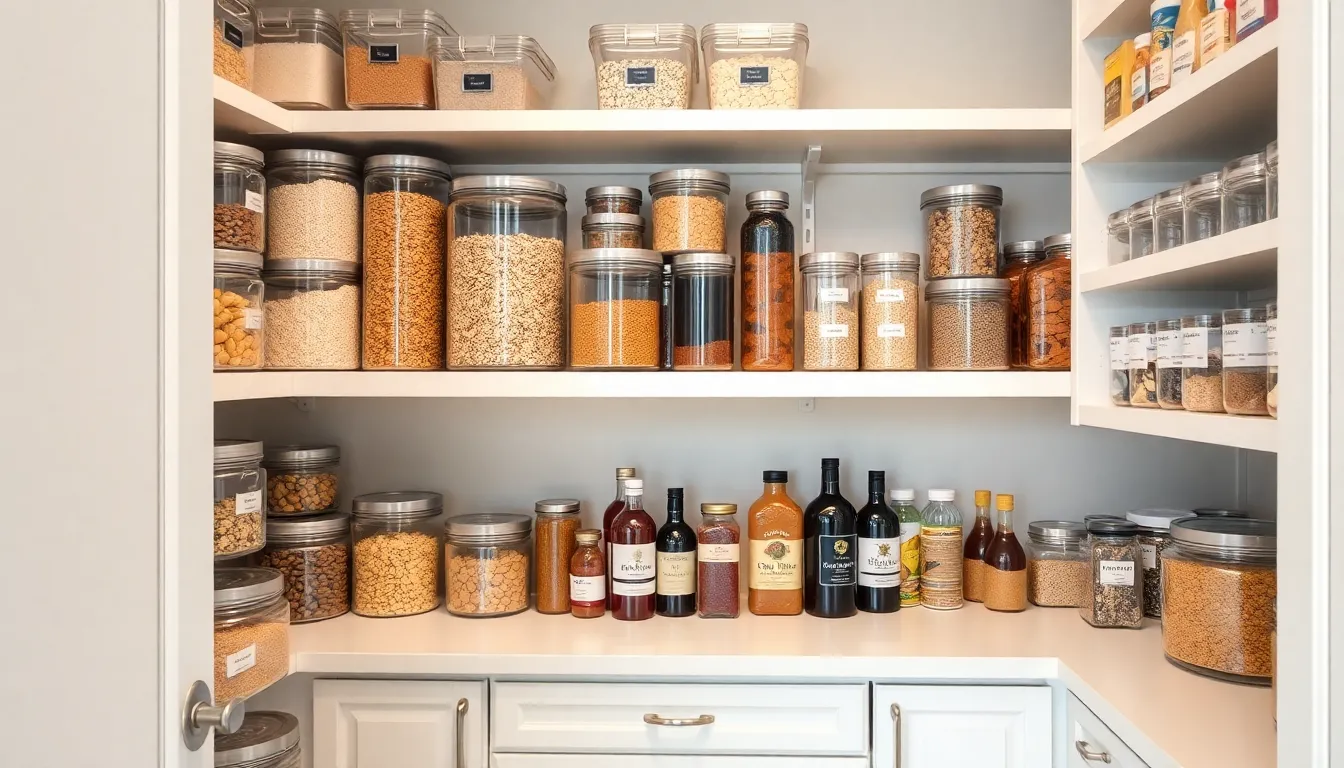
The right accessories can transform your corner pantry from a frustrating storage challenge into a highly functional space. Strategic additions will maximize accessibility and keep your pantry items organized for years to come.
Lazy Susans for Corner Accessibility
Lazy Susans are rotating platforms specifically engineered to solve corner pantry accessibility issues. We recommend these turntables because they allow you to reach items stored in hard-to-access corners by simply spinning the platform. Multiple sizes are available to fit different pantry dimensions and storage needs.
These rotating platforms work exceptionally well for oils, condiments, and spices that would otherwise disappear into dark corners. Items stay visible and within reach, eliminating the frustration of searching through cluttered shelves. Your pantry will maintain better organization since nothing gets lost in the back corners anymore.
Clear Storage Containers for Visibility
Clear, airtight storage containers provide instant visibility of your pantry contents while maintaining food freshness. We find these containers essential for preventing food spoilage and avoiding duplicate purchases at the grocery store. Transparency lets you see exactly what you have and how much remains at a peek.
Dry goods like pasta, cereal, snacks, and baking ingredients store perfectly in these containers. Uniform containers create a neat, orderly appearance that makes your corner pantry look professionally organized. Quick identification and retrieval become effortless when everything is clearly visible through transparent walls.
Labels and Inventory Systems for Organization
Labeling each container and shelf ensures items return to their designated spots after use. We recommend this system because it maintains consistent organization even when multiple family members access the pantry. Every item gets a proper home that everyone can identify and respect.
An inventory system helps track pantry contents and reduces waste from overbuying. Simple checklists, chalkboards, or magnetic boards work effectively for monitoring your supplies. Magnetic or chalkboard pantry doors serve as visual inventory aids where you can jot down notes or shopping reminders. These systems prevent forgotten items from expiring while keeping your shopping lists accurate and current.
Maintain Your Corner Kitchen Pantry for Long-Term Success
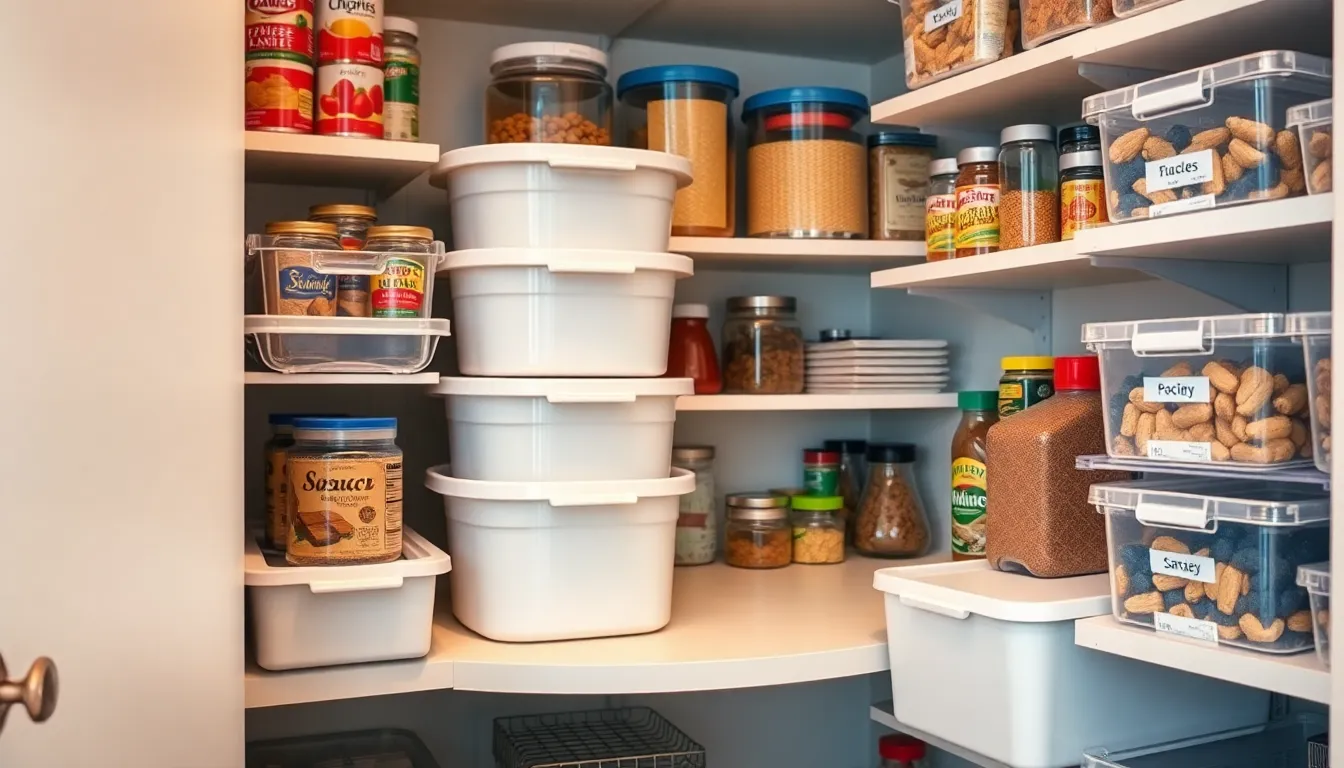
Creating an organized corner pantry is just the beginning. Sustaining its functionality requires consistent maintenance practices that keep our storage space efficient and accessible.
Regular Cleaning and Decluttering Schedule
Monthly shelf cleaning forms the foundation of corner pantry maintenance. We recommend wiping down all surfaces to remove dust and spills that naturally accumulate over time. Setting a exact date each month helps us maintain this routine without forgetting.
Decluttering requires discipline to avoid turning our pantry into a catch-all space. Items like cleaning supplies, pet food, or random household objects shouldn’t find their way into our kitchen storage area. We must regularly assess what belongs and what doesn’t.
Expired products need immediate removal during each cleaning session. Donating non-expired items we no longer need prevents overcrowding and ensures our pantry serves its intended purpose. This practice keeps our corner space functional rather than becoming a storage graveyard for forgotten purchases.
Inventory Management and Expiration Date Checks
Categorizing food and supplies by type creates an efficient system for long-term success. We group like items together, placing all canned goods in one section, baking supplies in another, and snacks in their designated area. This method prevents duplicate purchases and makes meal planning easier.
Clear containers, bins, and baskets make contents visible at a peek. Visibility becomes especially important in corner spaces where items can easily get lost or forgotten. We use transparent storage answers to maintain awareness of our inventory levels.
Stock rotation follows the “first in, first out” principle to minimize waste. Checking expiration dates during each cleaning session helps us use older items before they spoil. Container labeling speeds up identification and helps family members maintain our organizational system.
Seasonal Organization and Storage Adjustments
Seasonal transitions require strategic reorganization of our corner pantry space. Holiday baking supplies move to accessible shelves during December, while summer grilling essentials take priority during warmer months. We rotate items based on current cooking needs rather than letting seasonal products occupy prime real estate year-round.
Adjustable shelving, tiered storage, and Lazy Susans maximize our vertical and corner spaces during these transitions. These tools help us reconfigure our pantry layout without major renovations. We adjust shelf heights to accommodate different sized items as our storage needs change.
Family size changes and dietary shifts also influence our storage adjustments. Growing families need more bulk storage space, while empty nesters might prioritize specialty ingredients over quantity. We regularly evaluate whether our current system matches our household’s evolving needs.
| Maintenance Task | Frequency | Key Benefits |
|---|---|---|
| Shelf Cleaning | Monthly | Removes dust and spills |
| Expiration Checks | Monthly | Minimizes food waste |
| Inventory Assessment | Quarterly | Prevents overbuying |
| Seasonal Reorganization | 4 times yearly | Optimizes accessibility |
Conclusion
We’ve shown you how to transform your corner kitchen pantry from a frustrating dead zone into a highly functional storage powerhouse. With the right combination of pull-out drawers lazy Susans and tiered shelving systems you’ll maximize every inch of that awkward space.
Remember that proper lighting and clear organization systems are just as important as the physical storage answers. When you carry out these strategies and maintain them consistently your corner pantry will become one of the most efficient areas in your kitchen.
The key to long-term success lies in choosing answers that fit your exact needs and cooking habits. Start with one or two improvements and gradually build your perfect corner pantry system – you’ll wonder how you ever managed without it.
Frequently Asked Questions
What are the main benefits of organizing a corner kitchen pantry?
Corner kitchen pantries maximize storage in awkward spaces that often become cluttered. They improve accessibility to food items, reduce waste by keeping inventory visible, and transform frustrating dead zones into functional storage areas. With proper organization tools like lazy Susans and pull-out drawers, these spaces become efficient culinary command centers.
What are the most effective storage solutions for corner pantries?
The three most effective solutions are pull-out drawers with full-extension slides for deep corner access, tiered shelving systems to create distinct food zones, and door-mounted organizers that utilize pantry doors for frequently used items. These tools work together to maximize storage capacity and improve accessibility.
How should I organize items in my corner pantry for maximum efficiency?
Position frequently used items at eye level (5-6 feet high), create distinct zones for different food categories, and store heavy items on lower shelves for safety. Use labeled bins and dividers to maintain organization, and consider rotating lazy Susans for hard-to-reach items like snacks and condiments.
What type of shelving system works best for corner pantries?
Choose based on your needs: fixed shelves provide stability for heavy items and bulk storage, adjustable shelves offer versatility for seasonal reconfiguration, and wire shelving promotes air circulation to maintain food freshness. Many successful corner pantries combine multiple shelving types for optimal functionality.
How can I improve lighting in my corner pantry?
Install LED strip lights for even illumination, motion sensor lights for hands-free operation, and under-shelf lighting to eliminate dark corners. LED strips are energy-efficient and flexible, while motion sensors activate automatically when you enter. Under-shelf lighting provides direct illumination for better visibility.
What accessories help maximize corner pantry functionality?
Essential accessories include lazy Susans for corner accessibility, clear airtight containers for food freshness and visibility, and comprehensive labeling systems. Implement an inventory tracking system to monitor contents and expiration dates, reducing waste and preventing duplicate purchases while maintaining organization.
How often should I clean and reorganize my corner pantry?
Establish a monthly cleaning schedule that includes wiping down shelves and removing expired products. Check expiration dates regularly and adjust your layout seasonally based on cooking needs and family changes. Consistent maintenance ensures your corner pantry remains functional and accessible long-term.

